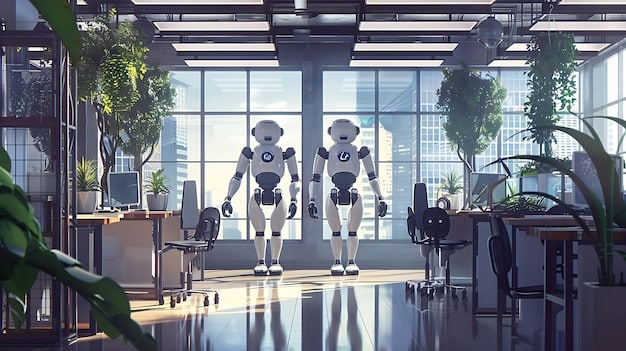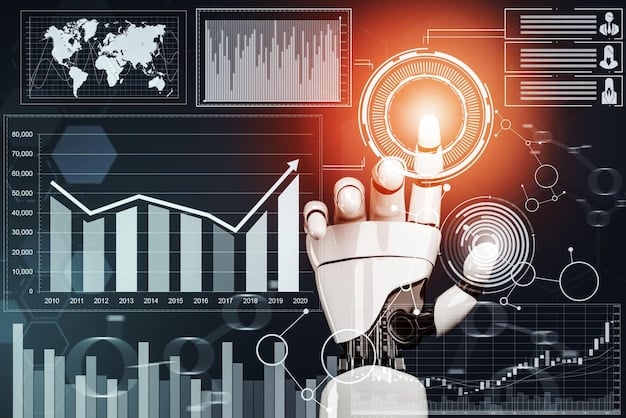The Impact of Automation on US Employment: Future of Work

The Impact of Automation on Employment and the Future of Work in the US is reshaping industries, raising concerns about job displacement while also creating new opportunities in technology and related fields.
The rise of automation is rapidly changing the landscape of work in the United States. The Impact of Automation on Employment and the Future of Work in the US is a complex issue with both challenges and opportunities for workers and the economy.
Understanding Automation’s Role in the US Economy
Automation, the use of technology to perform tasks with minimal human assistance, is increasingly prevalent in the US economy. It’s essential to understand the multifaceted role it plays, influencing everything from manufacturing to service industries.
The increasing adoption of automation technologies raises important questions about its impact on employment, job security, and the overall economic landscape in the United States.
Historical Context of Automation
Automation is not a new phenomenon. Throughout history, technological advancements have led to shifts in employment. However, the current pace of automation, powered by artificial intelligence (AI) and robotics, is unprecedented.
- The Industrial Revolution: Marked the first major wave of automation with the introduction of machines that replaced manual labor.
- The Computer Age: Brought about the automation of many office tasks and data processing, increasing efficiency in various sectors.
- The AI Revolution: Today, AI and machine learning are automating cognitive tasks previously thought to be exclusive to humans.

These waves of automation have continuously reshaped the job market, forcing workers to adapt to new roles and acquire new skills.
In conclusion, understanding the historical context of automation helps us to better anticipate and manage its future impact on employment in the US.
Job Displacement and Creation: The Automation Divide
One of the biggest concerns surrounding automation is job displacement. As machines become more capable, they can perform tasks previously done by human workers.
However, automation also leads to job creation by generating new roles in areas such as technology development, maintenance, and support.
Industries at Risk
Certain industries are more susceptible to job displacement due to automation. These include manufacturing, transportation, and administrative support.
- Manufacturing: Robots and automated systems can perform repetitive tasks faster and more efficiently than humans, leading to job losses.
- Transportation: Self-driving vehicles could displace millions of truck drivers and delivery personnel.
- Administrative Support: AI-powered software can automate tasks such as data entry, customer service, and scheduling, reducing the need for human workers.
These industries need to proactively address the challenges of automation by investing in retraining programs and supporting workers in transitioning to new roles.
Conversely, automation also spurs the creation of new jobs in sectors like software development, data analysis, and AI engineering. These jobs require specialized skills and education, highlighting the growing importance of STEM fields.
Skills for the Future: Adapting to Automation
To thrive in an automated world, workers need to develop skills that complement automation technologies. These skills include critical thinking, creativity, and complex problem-solving.
Focusing on these skills can help workers remain competitive and navigate the changing job market.
The Importance of Soft Skills
While technical skills are important, soft skills such as communication, collaboration, and emotional intelligence are becoming increasingly valuable. These skills are difficult to automate and essential for human interaction.
Workers who can effectively communicate, collaborate, and lead teams will be in high demand in the future of work.
- Critical Thinking: The ability to analyze information and make informed decisions is crucial in an automated environment.
- Creativity: As machines handle routine tasks, human creativity becomes more important for innovation and problem-solving.
- Adaptability: The willingness to learn new skills and adapt to changing circumstances is essential for long-term career success.
Investing in education and training programs that focus on these skills is crucial for preparing the workforce for the future.
In summary, adapting to automation requires a combination of technical and soft skills, as well as a commitment to lifelong learning.
The Role of Government and Policy
Government policies play a crucial role in managing the impact of automation on employment. These policies can support workers in transitioning to new jobs, promote education and training, and address income inequality.
Effective government intervention is essential for ensuring that the benefits of automation are shared broadly across society.
Policy Recommendations
Several policy recommendations can help mitigate the negative effects of automation and promote inclusive growth.
These include investing in retraining programs, expanding access to education, and implementing policies that support workers’ rights.
- Universal Basic Income (UBI): Providing a guaranteed income to all citizens can help alleviate poverty and reduce economic insecurity in an automated world.
- Skills Training Programs: Investing in programs that help workers acquire new skills can enable them to transition to high-demand jobs.
- Social Safety Nets: Strengthening unemployment benefits and other social safety nets can provide a cushion for workers who lose their jobs due to automation.

These policies can help ensure that the benefits of automation are shared broadly across society, promoting inclusive growth and reducing income inequality.
In conclusion, proactive government policies are essential for managing the impact of automation on employment and creating a more equitable future.
The Future of Work: Trends and Predictions
Looking ahead, several trends are likely to shape the future of work in the age of automation. These include the growth of the gig economy, the rise of remote work, and the increasing importance of lifelong learning.
Understanding these trends can help workers and businesses prepare for the challenges and opportunities ahead.
Emerging Trends
Several emerging trends are poised to transform the way we work. These trends include the increasing adoption of remote work, the growth of the gig economy, and the rise of AI-powered virtual assistants.
Embracing these trends can help workers and businesses adapt to the changing landscape of work and remain competitive.
- Remote Work: The rise of remote work is enabling workers to work from anywhere, increasing flexibility and improving work-life balance.
- Gig Economy: The gig economy is creating new opportunities for freelance and contract work, allowing workers to pursue their passions and earn income on their own terms.
- AI-Powered Virtual Assistants: AI-powered virtual assistants can automate many routine tasks, freeing up workers to focus on more complex and creative work.
In summary, the future of work is likely to be characterized by greater flexibility, autonomy, and the integration of AI technologies into the workplace.
By staying informed and adapting to these trends, workers and businesses can position themselves for success in the automated age.
Case Studies: Automation in Action
Examining specific case studies can provide valuable insights into the impact of automation on various industries and occupations. These case studies highlight both the challenges and the opportunities presented by automation.
Learning from these examples can help businesses and policymakers make informed decisions about how to manage the transition to an automated economy.
Examples of Automation in Different Sectors
Automation is transforming industries across the board. Here are some examples that show the diverse ways automation is being implemented.
These case studies highlight the need for proactive strategies to manage the impact of automation and ensure that its benefits are shared broadly.
- Amazon’s Warehouses: Amazon uses robots to automate many warehouse tasks, increasing efficiency and reducing costs.
- McDonald’s Self-Service Kiosks: McDonald’s is installing self-service kiosks in its restaurants, reducing the need for cashiers.
- Healthcare AI: AI algorithms are being used to diagnose diseases and personalize treatment plans, improving patient outcomes.
These examples demonstrate the transformative potential of automation, as well as the challenges it poses for employment and job security.
In conclusion, studying case studies of automation in action can provide valuable lessons for businesses, workers, and policymakers alike.
| Key Point | Brief Description |
|---|---|
| 🤖 Job Displacement | Automation may lead to job losses in manufacturing and transportation. |
| 💼 New Job Creation | Automation also creates jobs in tech and AI development. |
| 📚 Skills of the Future | Critical thinking, creativity, and adaptability will be key. |
| 🏛️ Government Role | Policies are important to manage transition and promote equality. |
Frequently Asked Questions
Automation is the use of technology to perform tasks with minimal human assistance. It can lead to job displacement in some industries while creating new job opportunities in others, particularly in technology-related fields.
Industries such as manufacturing, transportation, and administrative support are most at risk due to automation. These sectors often involve repetitive tasks that can be performed more efficiently by machines.
To succeed in an automated workplace, individuals need skills such as critical thinking, creativity, complex problem-solving, and adaptability. These skills are difficult to automate and are crucial for human interaction and innovation.
The government plays a crucial role in managing the impact of automation by implementing policies that support workers in transitioning to new jobs, promoting education and training, and addressing income inequality.
Emerging trends in the future of work include the growth of the gig economy, the rise of remote work, and the increasing importance of lifelong learning. These trends are reshaping the way people work and creating new opportunities.
Conclusion
In conclusion, the Impact of Automation on Employment and the Future of Work in the US presents both challenges and opportunities. By understanding these dynamics and taking proactive steps, it is possible to mitigate the negative effects and harness the benefits of automation.






